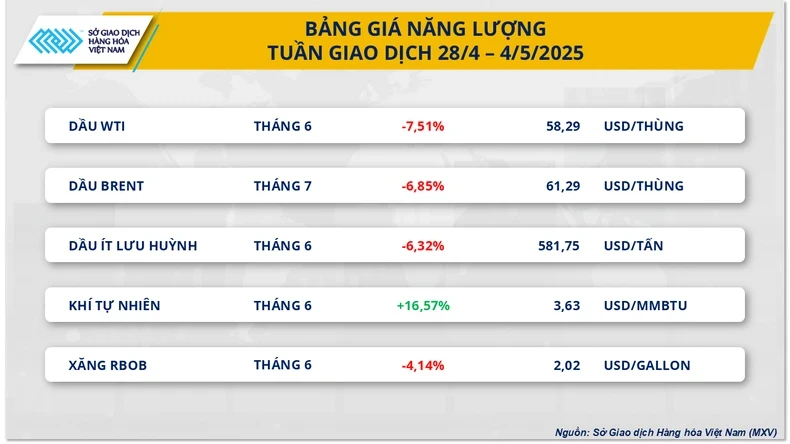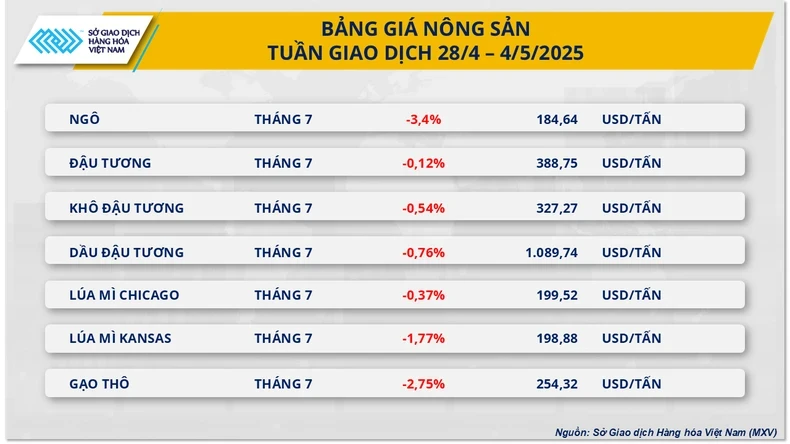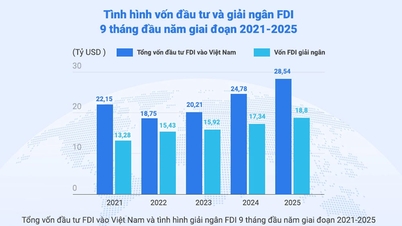
Crude oil prices plunged another week
Oil prices have just experienced a second consecutive week of decline in the context of the global market facing many uncertainties about supply, at the same time, investor sentiment is under pressure in the context of many concerns about the health of the world's number one economy .
At the end of the week, Brent crude oil price stopped at 61.29 USD/barrel, down 6.85%. WTI crude oil also recorded a decline of 7.51%, falling below the 60 USD/barrel threshold and closing at 58.29 USD/barrel.
The downward pressure on prices mainly comes from speculation about the possibility of OPEC+ will continue to increase production sharply in June, following the decision to increase production in May. This information, which appeared on April 23, has caused Brent and WTI oil prices to fall sharply in the first three sessions of the week, with a decrease of 5.61% and 7.63% respectively in just three days from April 28 to April 30. This information became even more negative when some OPEC+ members still produced more than their quotas, raising concerns about oversupply in the market. Notably, the meeting between the 8 OPEC+ member countries was also moved up two days earlier than expected on May 3, making the market wait even longer for the decision on June production.
In addition to the supply factor, a series of negative macroeconomic data from the US also contributed to increasing pressure on oil prices. During the three days of April 29-May 1, negative indicators were continuously announced, from the narrowing of the labor market, the decline in consumer confidence to the first decline in GDP in the first quarter of 2025 of the US in the past three years. Concerns about the US economic outlook led to doubts about future oil consumption demand.
However, investors still have expectations about the possibility of reaching new trade agreements between the US and major partners, especially between the US and China. Last week, China announced that the US had approached the world's second largest economy about future negotiations; information that helped to restrain the decline in oil prices.
In addition, the decline in US crude oil reserves as well as the decline in oil exports from Venezuela also contributed to the support for oil prices. In addition, the unstable developments in the US-Iran relationship also made the market speculate about the prospect of no more supply from Iran, the main reason for the only price recovery session this week on International Labor Day, May 1.
Agricultural product price list is flooded with red
At the close of last trading week, agricultural market recorded negative developments when all 7 commodities in the group weakened simultaneously. In particular, the corn and wheat markets simultaneously closed the trading week in red, clearly reflecting the impact of supply-demand factors as well as technical developments.
Corn prices alone recorded their third consecutive weekly decline, losing about 3.4% to $184 per ton, while wheat prices fell slightly by 0.37% to $199 per ton thanks to strong recovery in the last sessions of the week.
The downward pressure on corn prices comes from both technical and psychological factors after the previous unsustainable recovery. The latest Export Sales report shows that the US has sold only 1.01 million tons of corn for the 2024-2025 crop year, lower than the recent average. Despite the participation of many large customers such as South Korea, Vietnam, Israel and Mexico, demand is still not strong enough to create momentum for price increases. The news that Türkiye has opened a 1 million tons of duty-free import quota for corn is only a slight support and has not had a clear impact on the market.
On the weather front, favorable planting conditions in the US, coupled with positive crop conditions in South America, have eased supply concerns, adding pressure on corn prices this week.
In wheat, the market recorded a strong technical recovery in the last three sessions of the week after falling into oversold territory. The July contract recovered significantly thanks to technical buying and some supportive fundamentals. Although crop conditions in France remained stable, localized drought in northern Europe and the UK raised yield concerns. In the US, spring wheat planting progress as of April 27 was only 30% of the expected area, lower than market expectations and compared to the same period last year, thereby creating some concerns about this year's planting and supporting prices.
On the other hand, agricultural consultancy Sovecon has raised its forecast for Russian wheat exports in the 2024-2025 crop year to 40.7 million tonnes, adding to supply pressure on the global wheat market.
Source: https://baolangson.vn/luc-ban-ap-dao-mxv-index-roi-manh-xuong-2-169-diem-5046066.html





![[Photo] Solemn opening of the 1st Government Party Congress](https://vphoto.vietnam.vn/thumb/1200x675/vietnam/resource/IMAGE/2025/10/13/1760337945186_ndo_br_img-0787-jpg.webp)

























![[Photo] General Secretary To Lam attends the opening of the 1st Government Party Congress](https://vphoto.vietnam.vn/thumb/1200x675/vietnam/resource/IMAGE/2025/10/13/1760321055249_ndo_br_cover-9284-jpg.webp)










































































Comment (0)